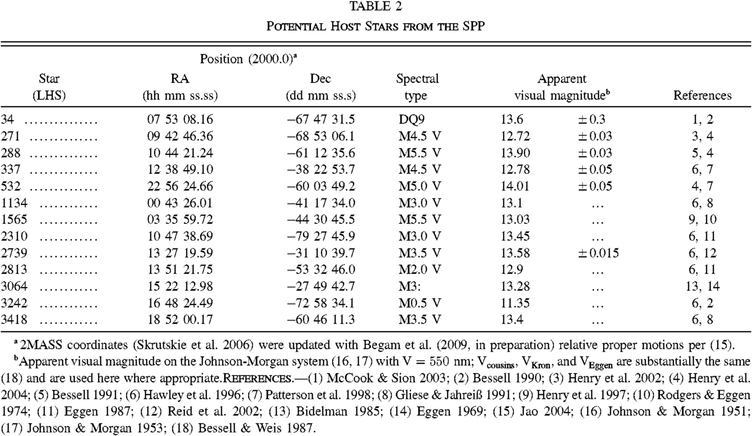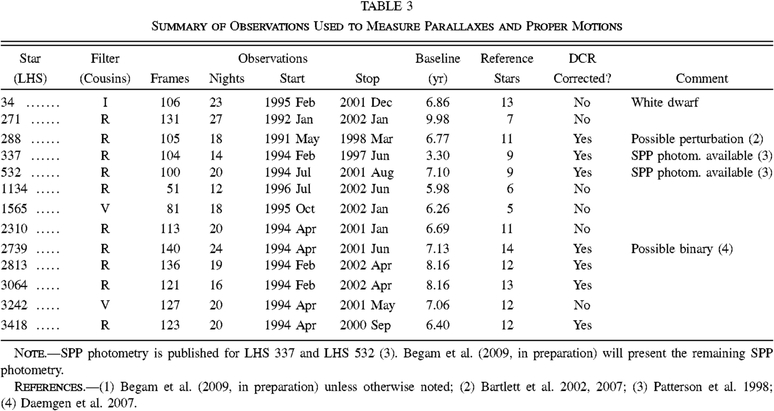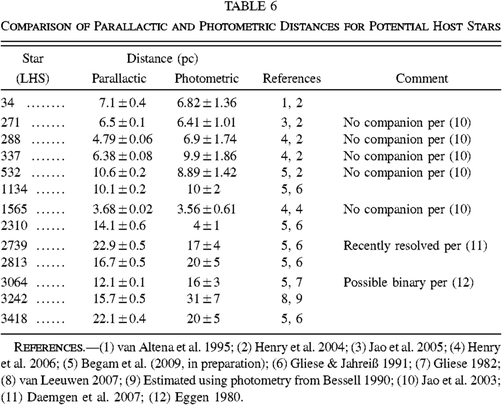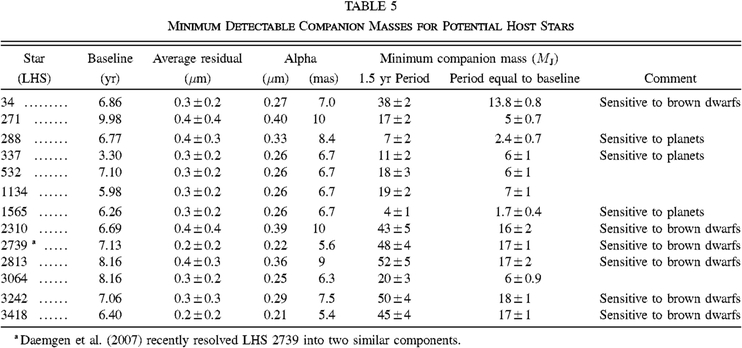ABSTRACT
Thirteen nearby stars from the former University of Virginia Southern Parallax Program were tested for possible astrometric perturbations that might indicate very low mass companions. For 12 of these stars—LHS 34, 271, 337, 532, 1134, 1565, 2310, 2739, 2813, 3064, 3242, and 3418—no clear indication of any unseen companion was detected. One star, LHS 288, however, may have a perturbation meriting further investigation. These high proper motion stars are all members of the solar neighborhood, lying within 25 pc. Other than the white dwarf LHS 34, these stars are early M dwarfs (M0.5–M5.5 V). After a minimum of 50 observations spread over at least three years, the relative parallax solutions for these stars have errors less than 3 mas. Following the calculation of relative parallaxes and proper motions, time-series analyses using Lomb-Scargle periodograms tested the astrometric residuals for any additional periodic signals. An upper limit to the mass of companions that could remain undetected was estimated for each star individually.
Export citation and abstract BibTeX RIS
1. INTRODUCTION
The stellar multiplicity fraction constrains theories of stellar formation, evolution of stellar systems, and the history of the Galaxy. It also plays a significant role in the search for very low mass companions, including brown dwarfs and planets, and in the development of the mass-luminosity relationship. Approximately 67% of solar-type stars appear to have stellar companions (Duquennoy & Mayor 1991), while 12% appear to host at least one planet (Marcy et al. 2005). Worley (1977) found that 58% of nearby stars have one or more companions. However, the fraction appears smaller for lower mass stars. Only 32–42% of M dwarfs are the primary star in a multiple configuration (Worley 1977; Henry & McCarthy 1990; Fischer & Marcy 1992). Identification of additional low-mass binary systems could further clarify this fraction and provide needed inputs to the mass-luminosity relationship. Small changes in the mass-luminosity relationship for the lowest mass stars, which are so populous, can have a significant effect on calculations of the Galactic mass (Henry 2004). Currently, the mass-luminosity relationship appears most likely to flatten for the lowest mass stars (Reid et al. 2002). The structure of this relationship could constrain theories about the formation of these cool objects.
Planets, the lowest mass companions, should be common if they form as by-products of star formation. Fewer planets have been detected orbiting M dwarfs than anticipated (Butler et al 2004). Radial-velocity programs are currently observing more than 200 M dwarfs with masses between 0.2 and 0.6 M⊙ (∼M0–M5), but fewer than 10 M dwarfs are known planetary hosts. Of these systems, two host planets that are as massive as Jupiter. Although radial-velocity studies of M dwarfs have relatively short temporal baselines, the occurrence of Jovian-mass planets appears to be three to six times more likely around solar-type stars than M dwarfs (Butler et al. 2006). Certain core accretion models predict this apparent paucity of Jovian-mass planets because lower protoplanetary disk masses and longer orbital time scales should produce more Neptunian-mass planets around M dwarfs (Laughlin et al. 2004). If, however, protoplanetary disk masses do not scale strictly with stellar mass, then Kornet et al. (2006) indicate that the frequency of Jovian-mass planets should increase for lower mass stars relative to solar-type stars. Therefore, the frequency, size, and distribution of planets orbiting M dwarfs can provide a significant test of these planet-formation models.
Astrometric searches for very low mass companions complement radial-velocity observations in a number of ways. They are sensitive to companions in larger orbits that produce noticeable stellar displacements, a bias opposite that of radial-velocity searches. Therefore, they could confirm the presence of outer planets suggested by velocity residuals for systems with known short-period planets, such as those described by Fischer et al. (2001). Candidates for astrometric observations are not restricted by age, spectral type, or stellar rotation. Such programs can identify the frequency of planets around the low-mass stars that make up so much of the solar neighborhood. The eventual determination of all the orbital elements, including inclination, is possible with astrometric observations. Knowing the orbital inclination of a system allows the determination of actual masses and whether multiple planets have coplaner orbits (Quirrenbach et al. 2004).
Although a tailored astrometric planet search could obtain a wealth of information about extrasolar planets, the University of Virginia (UVa) Southern Parallax Program (SPP; Ianna 1993) was not designed specifically for these goals. More generally, the SPP sought to identify new stellar members of the solar neighborhood. After measuring the parallaxes and proper motions of possible members, the astrometric residuals were examined for any periodic perturbations that might indicate unseen companions; determining the associated orbital elements would have required additional observations. Until recently, most of the lowest luminosity stars were found through their associated astrometric perturbations, primarily at Sproul Observatory (Lippincott 1978). Because these stars have low masses, their reflex displacement will be greater for a given companion mass. In addition, because these stars are close, the angular size of that displacement (αpert in seconds of arc) will be more easily detected

where Mc and M∗ are the masses of the companion and its host, respectively, in solar mass units; a is the semimajor axis in astronomical units (AU); and d is the distance in parsecs (pc). The detection or nondetection of such companions would provide new data about multiplicity trends in the solar neighborhood. Therefore, the detection of any companions, regardless of mass, would be of scientific significance. New nearby low-mass binaries would help define the mass-luminosity relationship for the lower main sequence and provide constraints on formation theories for brown dwarfs and planets (Delfosse et al. 2000; Henry 2004).
2. MEASUREMENT AND ANALYSIS
The SPP observed approximately 90 stars from 1987–2002 using the 40 inch (1 m) Ritchey-Chrétien reflector at Siding Spring Observatory, which has a focal plane scale of 25.55'' mm-1. Over the course of the observations, different charge-coupled devices (CCDs) were used with the telescope; Table 1 details the two astrometric detectors. Observations were made through Cousins (1980a, 1980b) filters: Vc (551.28 nm), Rc (654.82 nm), and Ic (816.10 nm) (M. Bessell 1999, private communication). Each star, along with 5–14 reference stars, was observed multiple times, mostly during periods of high parallax factor and usually within 30 minutes of the transit to minimize differential color refraction (DCR). When possible, the SPP used photometry and weather records to model and correct the positions of stellar images for DCR before calculating parallaxes and proper motions. The initial data reduction, including flat-fielding, was performed using Figaro routines. Sky flats were collected nightly, usually at either the beginning or end of the observations. Initially, the bias subtraction was performed using information from the CCD overscan region. However, the signal-to-noise ratio for the parallax frames was sufficiently high that bias subtraction was discontinued when the Configurable Instrument Control and Data Acquisition (CICADA) system was implemented. Nonetheless, the collection of bias frames for comparison and calibration continued throughout the program. Begam et al. (2009, in preparation) provide additional details, including the DCR model, which is essentially that of Stone (1996).
 |
Each relative parallax and proper motion was measured with respect to reference stars that were selected to surround the possible nearby star as completely as possible. These reference stars were also chosen to have apparent brightnesses similar to that of the star of interest. Identifiable close binaries were excluded as possible reference stars. Begam et al. (2009, in preparation) discusses the selection of reference stars further.
From the overall SPP program, 12 stars, with spectral types from early to middle M, and one white dwarf were selected for time-series analysis. These members of the solar neighborhood lie between 3.5 and 22 pc away. Observations cover periods between 3.3 and 10.0 yr. The resulting errors in the relative parallaxes are less than 3 mas. Tables 2 and 3 describe the selected stars and their observations.
 |
 |
The McCormick Parallax Reduction Program, an iterative three plate-constant adjustment model, was used to calculate the relative parallaxes and proper motions listed in Table 4. The mean errors of unit weight range from 0.3 to 0.8 μm, or 7 to 20 mas, with an average of 0.4 ± 0.1 μm, or 10 ± 2 mas, in the x-coordinate (right ascension) and of 0.4 ± 0.1 μm, or 11 ± 3 mas, in the y-coordinate (declination). Figures 1 and 2 show nightly residuals for LHS 337 and 1565, respectively.
Fig. 1.— LHS 337 nightly residuals. Residuals to the relative parallax and proper motion solution were averaged by night. The upper plot shows the average residual by night in the x-coordinate (RA) while the lower plot shows the corresponding values in the y-coordinate (Dec).
Fig. 2.— LHS 1565 nightly residuals. Residuals to the relative parallax and proper motion solution were averaged by night. The upper plot shows the average residual by night in the x-coordinate (RA) while the lower plot shows the corresponding values in the y-coordinate (Dec).
 |
Following the removal of proper motion and parallax, the x- and y-residuals associated with each observation were subjected to a time-series analysis using the Lomb-Scargle normalized periodogram method (Press et al. 1996). The x- and y-residuals for each single night were then combined and a new pair of periodograms were calculated for each star. Because the SPP observational baselines are less than a decade in duration, annual normal points were too sparse to be considered. Frequencies up to four times the effective Nyquist frequency were searched for each star. Although averaging the data can improve detection efficiency, it also reduces the effective Nyquist frequency, which may drop below the signal frequency, making detection more difficult (Scargle 1982). For these stars, the effective Nyquist frequencies remained higher than the lowest independent frequencies, even when the residuals for each night were averaged.
Significant peaks in both the x- and y-residual periodograms at the same frequency would indicate the possible presence of a companion. In rare cases, such as an orbital inclination near 90°, a strong peak might appear in only one coordinate. When the individual residuals are combined into nightly normal points, the resulting periodograms should also show similar peaks. Parallax observations are made primarily in the morning and evenings and, in this case, were usually scheduled during bright observing time. The cyclical nature of this observing schedule may produce signals at frequencies close to the synodic month, 6 months, and 1 year (Black & Scargle 1982). However, astrometric techniques are more sensitive to long-period planets (Quirrenbach et al. 2004).
None of the periodograms calculated for any of the stars clearly and definitively indicates the presence of any unseen companion. For example, Figures 3 and 4 are periodograms calculated using nightly residuals for LHS 337 and 1565, respectively. The figures appear to rule out planets with masses greater than 6 ± 1 MJ in 3 yr orbits around LHS 337 and with masses of 1.7 ± 0.5 MJ in 6 yr orbits around LHS 1565. These periodograms are typical of those generated for the M dwarfs in this study. LHS 288, however, shows some interesting features (Bartlett et al. 2002, 2007); the possibility that LHS 288 hosts a very low mass companion will be discussed separately in greater detail (Bartlett et al. 2009, in preparation).
Fig. 3.— LHS 337 periodograms using nightly residuals. Solid curve is periodogram for x-coordinate (RA). Dashed curve is periodogram for y-coordinate (Dec). Horizontal lines in the periodograms indicate the likelihood that spectral peaks exceeding that power are real and not caused by noise only. Dash double-dotted line is 99% confidence, dash dotted line is 90% confidence, and dotted line is 50% confidence.
Fig. 4.— LHS 1565 periodograms using nightly residuals. Solid curve is periodogram for x-coordinate (RA). Dashed curve is periodogram for y-coordinate (Dec). Horizontal lines in the periodograms indicate the likelihood that spectral peaks exceeding that power are real and not caused by noise only. Dash double-dotted line is 99% confidence, dash dotted line is 90% confidence, and dotted line is 50% confidence.
Although the other stars in this study are M dwarfs, LHS 34 is a white dwarf. Such stellar remnants can be the primary star in a low-mass system; Farihi et al. (2005) identified two L dwarf companions and nine M dwarf companions later than spectral type M4.5 in a survey of 261 white dwarfs. Furthermore, modeling of the post–main-sequence evolution of stars and their planetary systems indicate that some outer planets may survive to orbit the final remnant (Duncan & Lissauer 1998; Debes & Sigurdsson 2002; Villaver & Livio 2007). Mullally et al. (2008) report the possible detection of a giant planet orbiting GD 66. However, LHS 34 does not appear to have companions more massive than 13.8 ± 0.8 MJ in 7 yr orbits, as shown in Figures 5 and 6.
Fig. 5.— LHS 34 nightly residuals. Residuals to the relative parallax and proper motion solution were averaged by night. The upper plot shows the average residual by night in the x-coordinate (RA) while the lower plot shows the corresponding values in the y-coordinate (Dec).
Fig. 6.— LHS 34 periodograms using nightly residuals. Solid curve is periodogram for x-coordinate (right ascension). Dashed curve is periodogram for y-coordinate (declination). Horizontal lines in the periodograms indicate the likelihood that spectral peaks exceeding that power are real and not caused by noise only. Dash double-dotted line is 99% confidence, dash dotted line is 90% confidence, and dotted line is 50% confidence.
The comparison of distances measured directly from parallaxes with those estimated from photometry may signify the presence of an unknown very low-mass companion. The joint photometry of an unresolved binary will appear brighter than it would if its individual components were considered separately so that the resulting photometric distance will underestimate the actual distance to the star. For instance, a pair whose magnitudes differ by 0.75 mag will appear about 18% closer than if only the flux from a single component was considered. Table 6 lists parallactic and photometric distances for each of the stars in this sample. With the exception of LHS 2310, none of the parallactic distances are more than 1.5 greater than the photometric distance, which is consistent with lack of companions indicated by the periodograms.
 |
Despite expectations of finding at least one substellar companion amongst the stars observed by the SPP, no such body was clearly detected. Because the number of extrasolar planets found to date remains small, nondetections may contribute to our understanding of planetary frequency. Therefore, the upper limits on the masses of companions that this study would miss were estimated. Assuming a circular orbit for simplicity, Kepler's third law estimates the minimum detectable companion mass (Mc)

where M∗ is the stellar mass in solar mass units, P is the period in years, and αmin and π are the minimum detectable perturbation and absolute parallax, respectively, in mas.
Known binary systems were excluded from this study, so the masses of potential host stars must be estimated from an appropriate mass-radius relationship or mass-luminosity relationship. The former applies only to LHS 34 for which Bergeron et al. (2001) obtained a mass of 0.72 ± 0.06 M⊙. The majority of the stars in this study are M dwarfs so their masses were estimated from the K-band mass-luminosity relationship derived by Delfosse et al. (2000) using Two Micron All Sky Survey (Skrutskie et al. 2006) photometry.
The periods considered also affect the ability to detect companions of various sizes. Ideally, the observations should span more than a single orbit in order to separate the companion-induced perturbation from the proper motion term adequately (Black & Scargle 1982). The longest period considered for each star was its observational baseline. A planet with a 1 yr orbit is likely to be confused with the annual parallax-observing cycle. Therefore, the shortest period considered was 1.5 yr in every case.
Setting the minimum detectable perturbation (αmin) is the most subjective step because the quality and quantity of available data varies and because misleading peaks will appear in a periodogram when a large number of frequencies are evaluated (Scargle 1982). Perturbations of 10–20 mas have been suggested in literature (Campbell et al. 1988; Heintz, W. 1988, private communication in Marcy & Benitz 1989). Bartlett (2007) indicates that a perturbation must be about 92% of the magnitude of the average residual in order to be detected. Using this ratio, Table 5 estimates the minimum detectable perturbation for each potential host, which range from 5.4 to 10 mas, and provides the corresponding minimum detectable companion masses for the short and long periods associated with each potential host. For low-mass stars, like these, the detection of any companion would be significant.
 |
For short-period orbits, the SPP data might have detected planets around LHS 288, 337, and 1565. For the other stars, the minimum detectable mass is in the brown dwarf range greater than 13 MJ. In most cases, brown dwarfs with periods of a few years should have been identified. In addition, these periods correspond to separations smaller than 4 AU. Planets, especially moderate gas giants and smaller, may still be present.
Three other groups have also investigated whether some of the stars in this study might host companions. Jao et al. (2003) examined astrometric images of 209 stars taken as part of the Cerro Tololo Inter-American Observatory Parallax Investigation (CTIOPI) for companions within 20'' of the parallax star. They found no companions to LHS 271, 288, 337, 532, or 1565. The eight new multiples detected by their study are all probably very low mass main-sequence stars or white dwarfs. Eggen (1980) commented that LHS 3064 could be resolved into two components of equal brightness under good conditions. Nothing in this current work supports his suggestion. On the other hand, Daemgen et al. (2007) recently resolved LHS 2739 into two similar components with the Altair adaptive optics system on the Gemini North telescope, for which they estimate an orbit of 108 ± 43 yr. SPP observations cover a small fraction of this period and would be unlikely to detect the resulting perturbation.
3. DISCUSSION
If 32–42% of M dwarfs have stellar companions (Worley 1977; Henry & McCarthy 1990; Fischer & Marcy 1992) and 12% of stars host at least one giant planet within 20 AU (Marcy et al. 2005), then the approximately 90 SPP stars might include as many as 38 multiple systems with 11 planetary systems. The failure to detect the clear signal of a companion of any kind in this selection of the SPP stars is disappointing but consistent with gas giants being less common around M dwarfs than solar-type stars as suggested by Butler et al. (2006) and predicted by Laughlin et al. (2004). However, if the suggested perturbation of LHS 288 (Bartlett et al. 2002, 2007) is not spurious, then the detection of a single planet in this sample is well within expectations. The detection of astrometric companions is biased toward massive planets in long-period orbits. Although the baselines available here are sufficient to determine parallaxes, they do not appear to be adequate for detecting very low mass companions; the average baseline is 7 ± 2 yr. Another 2–6 yr would have brought the sensitivity to long-period perturbations within planetary range around all of the stars. More observations over the course of the SPP would have reduced the residuals and improved the sensitivity to lower mass companions. However, neither option was available to this program.
Large perturbations are easily detected when astrometric residuals are reviewed. The smaller perturbations that might be associated with brown dwarfs or planets require a more sensitive technique, such as time-series analysis, for identification. Selecting stars for further analysis based on the quality of their parallax solution can be approached in one of two ways. As done here, potential hosts may be selected for small errors associated with their final parallax that should be accompanied by small residuals. A perturbation due to a companion should stand out from the noise in such residuals. On the other hand, the small errors may be an indication that no orbital component is present. In the alternative approach, larger errors may identify host candidates. The corresponding large residuals may be evidence of the presence of an orbital component. However, such large perturbations are usually obvious and the large error generally reflects noisy or sparse data. During the selection of this subsample, another nine stars were considered for inclusion but failed to meet the final criteria. Perhaps one of these harbors a yet unseen companion.
R. J. Patterson provided valuable guidance throughout the astrometric data reduction.
This research made use of the NASA ADS Abstract System; the ADC at NASA's Goddard Space Flight Center; the SIMBAD, operated at CDS, France; VizieR; and Aladin. The authors also acknowledge the data analysis facilities (Figaro) provided by the Starlink Project, which is run by the Council for the Central Laboratory of the Research Councils (CCLRC) on behalf of the Particle Physics and Astronomy Research Council (PPARC).
This research made use of data products from 2MASS, which is a joint project of the University of Massachusetts and the Infrared Processing and Analysis Center/California Institute of Technology, funded by NASA.
The authors gratefully acknowledge support from NSF grants AST 98–20711 (PI Ianna) and 05–07711, Georgia State University, NASA-SIM, the University of Virginia Governor's Fellowship, Hampden-Sydney College, the US Naval Observatory, and the F. H. Levinson Fund of the Peninsula Community Foundation. In addition, the SPP acknowledges support from the Research School of Astronomy and Astrophysics, Australian National University, and thanks them for generous allocations of observing time at Siding Spring Observatory.






